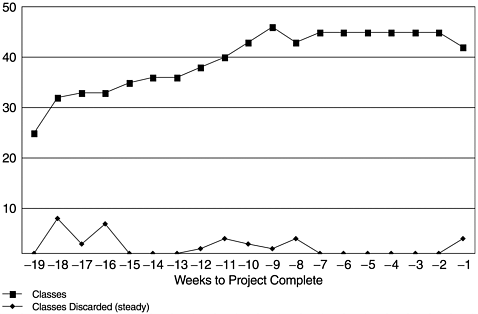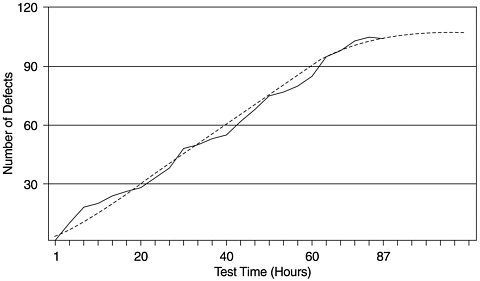Quality and Quality Management Metrics
In procedural programming, quality is measured by defects per thousand LOC (KLOC), defects per function point, mean time to failure, and many other metrics and models such as those discussed in several previous chapters. The corresponding measure for defects per KLOC and defects per function point in OO is defects per class. In search of empirical data related to OO defect rates, we noted that data about OO quality is even more rare than productivity data. Table 12.7 shows the data that we tracked for some of the projects we discuss in this chapter.
Testing defect rates for these projects ranged from 0.21 defects per class to 0.69 per class and from 2.6 defects per KLOC (new and changed code) to 8.2 defects per KLOC. In our long history of defect tracking, defect rates during testing when the products were under development ranges from 4 defects per KLOC to about 9 defects per KLOC for procedural programming. The defect rates of these OO projects compare favorably with our history. With one year in the field, the defect rates of these products ranged from 0.01 defects per class to 0.05 defects per class and from 0.05 defects per KLOC to 0.78 defects per KLOC. Again, these figures, except the defects/KLOC for Project B, compare well with our history.
With regard to quality management, the OO design and complexity metrics can be used to flag the classes with potential problems for special attention, as is the practice at the NASA SATC. It appears that researchers have started focusing on the empirical validation of the proposed metrics and relating those metrics to managerial variables . This is certainly the right direction to strengthen the practical values of OO metrics. In terms of metrics and models for in-process quality management when the project is under development, we contend that most of the metrics discussed in this book are relevant to OO projects, for example, defect removal effectiveness, the inspection self-assessment checklist (Table 9.1), the software reliability growth models (Chapters 8 and 9), and the many metrics for testing (Chapter 10). Based on our experience, the metrics for testing apply equally well to OO projects. We recommend the following:
Table 12.7. Testing Defect Rate and Field Defect Rates for Some OO Projects
|
Project B (C++) |
Project C (C++) |
Project D (Smalltalk) |
Project F (Smalltalk) |
|
|---|---|---|---|---|
|
Testing Defect Rate |
||||
|
Defects/Class |
0.21 |
0.82 |
0.27 |
0.69 |
|
Defects/KLOC |
3.1 |
8.2 |
2.6 |
5.9 |
|
Field Defect Rate (1 Year After Delivery) |
||||
|
Defects/Class |
0.05 |
na |
0.04 |
0.01 |
|
Defects/KLOC |
0.78 |
na |
0.41 |
0.05 |
- Test progress S curve
- Testing defect arrivals over time
- Testing defect backlog over time
- Number of critical problems over time
- Number of system crashes and hangs over time as a measure of system stability
- The effort/outcome paradigm for interpreting in-process metrics and for in-process quality management
Furthermore, for some simple OO metrics discussed in this chapter, when we put them into the context of in-process tracking and analysis (for example, trend charts ), they can be very useful in-process metrics for project and quality management. We illustrate this point below with the examples of a small project.
Project MMD was a small, independent project developed in Smalltalk with OO methodology and iterative development process over a period of 19 weeks (Hanks, 1998). The software provided functions to drive multimedia devices (e.g., audio and video equipment) and contained 40 classes with about 3,200 lines of code. The team consisted of four members ”two developers for analysis, design, and cod-ing, and two testers for testing, tracking, and other tasks required for the product to be ready to ship. With good in-process tracking and clear understanding of roles and responsibilities, the team conducted weekly status meetings to keep the project moving. Throughout the development process, four major iterations were completed. Figure 12.3 shows the trends of several design and code metrics over time. They all met the threshold values recommended by Lorenz (1993). Figure 12.4 shows the number of classes and classes discarded over time (i.e., metric number 11 in Table 12.1.). The trend charts reflect the several iterations and the fact that iterative development process was used.
Figure 12.3. Trends of Several OO Metrics

Figure 12.4. Class Statistics over Time

Figure 12.5 shows the relationship between defect arrivals and testing time, with a fitted curve based on the delayed S reliability growth model. This curve fitting confirms the applicability of reliability growth models to data from OO projects. In fact, we contend that this match may be even better than data from procedural software projects, because in OO environment, with the class structure, the more difficult bugs tend to be detected and "flushed" out earlier in the testing process.
Figure 12.5. OO Testing Defect Arrivals Follow the Pattern of a Software Reliability Growth Model

Finally, if we use this project as another data point for productivity estimates, with 40 classes and 76 person-weeks (4 x 19 weeks) and assuming 4.33 person-weeks per person-month (PM), we get 2.3 classes per PM. This number falls between the numbers for the framework-related projects (1.2 and 1.9 classes per PM) and the mature systems software projects (about 4 classes per PM).
What Is Software Quality?
Software Development Process Models
- Software Development Process Models
- The Waterfall Development Model
- The Prototyping Approach
- The Spiral Model
- The Iterative Development Process Model
- The Object-Oriented Development Process
- The Cleanroom Methodology
- The Defect Prevention Process
- Process Maturity Framework and Quality Standards
Fundamentals of Measurement Theory
- Fundamentals of Measurement Theory
- Definition, Operational Definition, and Measurement
- Level of Measurement
- Some Basic Measures
- Reliability and Validity
- Measurement Errors
- Be Careful with Correlation
- Criteria for Causality
Software Quality Metrics Overview
- Software Quality Metrics Overview
- Product Quality Metrics
- In-Process Quality Metrics
- Metrics for Software Maintenance
- Examples of Metrics Programs
- Collecting Software Engineering Data
Applying the Seven Basic Quality Tools in Software Development
- Applying the Seven Basic Quality Tools in Software Development
- Ishikawas Seven Basic Tools
- Checklist
- Pareto Diagram
- Histogram
- Run Charts
- Scatter Diagram
- Control Chart
- Cause-and-Effect Diagram
- Relations Diagram
Defect Removal Effectiveness
- Defect Removal Effectiveness
- Literature Review
- A Closer Look at Defect Removal Effectiveness
- Defect Removal Effectiveness and Quality Planning
- Cost Effectiveness of Phase Defect Removal
- Defect Removal Effectiveness and Process Maturity Level
The Rayleigh Model
- The Rayleigh Model
- Reliability Models
- The Rayleigh Model
- Basic Assumptions
- Implementation
- Reliability and Predictive Validity
Exponential Distribution and Reliability Growth Models
- Exponential Distribution and Reliability Growth Models
- The Exponential Model
- Reliability Growth Models
- Model Assumptions
- Criteria for Model Evaluation
- Modeling Process
- Test Compression Factor
- Estimating the Distribution of Total Defects over Time
Quality Management Models
- Quality Management Models
- The Rayleigh Model Framework
- Code Integration Pattern
- The PTR Submodel
- The PTR Arrival and Backlog Projection Model
- Reliability Growth Models
- Criteria for Model Evaluation
- In-Process Metrics and Reports
- Orthogonal Defect Classification
In-Process Metrics for Software Testing
- In-Process Metrics for Software Testing
- In-Process Metrics for Software Testing
- In-Process Metrics and Quality Management
- Possible Metrics for Acceptance Testing to Evaluate Vendor-Developed Software
- How Do You Know Your Product Is Good Enough to Ship?
Complexity Metrics and Models
- Complexity Metrics and Models
- Lines of Code
- Halsteads Software Science
- Cyclomatic Complexity
- Syntactic Constructs
- Structure Metrics
- An Example of Module Design Metrics in Practice
Metrics and Lessons Learned for Object-Oriented Projects
- Metrics and Lessons Learned for Object-Oriented Projects
- Object-Oriented Concepts and Constructs
- Design and Complexity Metrics
- Productivity Metrics
- Quality and Quality Management Metrics
- Lessons Learned from OO Projects
Availability Metrics
- Availability Metrics
- 1 Definition and Measurements of System Availability
- Reliability, Availability, and Defect Rate
- Collecting Customer Outage Data for Quality Improvement
Measuring and Analyzing Customer Satisfaction
- Measuring and Analyzing Customer Satisfaction
- Customer Satisfaction Surveys
- Analyzing Satisfaction Data
- Satisfaction with Company
- How Good Is Good Enough
Conducting In-Process Quality Assessments
- Conducting In-Process Quality Assessments
- The Preparation Phase
- The Evaluation Phase
- The Summarization Phase
- Recommendations and Risk Mitigation
Conducting Software Project Assessments
- Conducting Software Project Assessments
- Audit and Assessment
- Software Process Maturity Assessment and Software Project Assessment
- Software Process Assessment Cycle
- A Proposed Software Project Assessment Method
Dos and Donts of Software Process Improvement
- Dos and Donts of Software Process Improvement
- Measuring Process Maturity
- Measuring Process Capability
- Staged versus Continuous Debating Religion
- Measuring Levels Is Not Enough
- Establishing the Alignment Principle
- Take Time Getting Faster
- Keep It Simple or Face Decomplexification
- Measuring the Value of Process Improvement
- Measuring Process Adoption
- Measuring Process Compliance
- Celebrate the Journey, Not Just the Destination
Using Function Point Metrics to Measure Software Process Improvements
- Using Function Point Metrics to Measure Software Process Improvements
- Software Process Improvement Sequences
- Process Improvement Economics
- Measuring Process Improvements at Activity Levels
Concluding Remarks
- Concluding Remarks
- Data Quality Control
- Getting Started with a Software Metrics Program
- Software Quality Engineering Modeling
- Statistical Process Control in Software Development
A Project Assessment Questionnaire
EAN: 2147483647
Pages: 176
